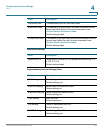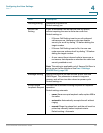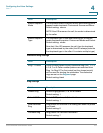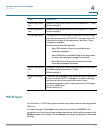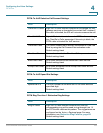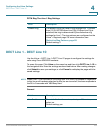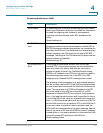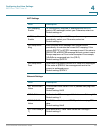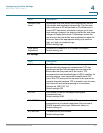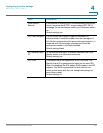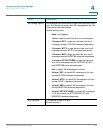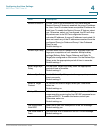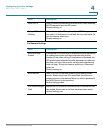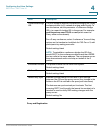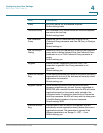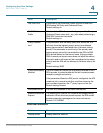
Configuring the Voice Settings
DECT Line 1 - DECT Line 10
Cisco SPA232D Administration Guide 157
4
SIP Settings
Network Jitter
Level
Determines how jitter buffer size is adjusted by the ATA.
Jitter buffer size is adjusted dynamically. The minimum
jitter buffer size is 30 milliseconds or (10 milliseconds +
current RTP frame size), whichever is larger, for all jitter
level settings. However, the starting jitter buffer size value
is larger for higher jitter levels. This setting controls the
rate at which the jitter buffer size is adjusted to reach the
minimum. Select the appropriate setting: low, medium,
high, very high, or extremely high.
Default setting: high
Jitter Buffer
Adjustment
Choose yes to enable or no to disable this feature.
Default setting: yes
Field Description
SIP Transport The TCP choice provides “guaranteed delivery”, which
assures that lost packets are retransmitted. TCP also
guarantees that the SIP packages are received in the
same order that they were sent. As a result, TCP
overcomes the main disadvantages of UDP. In addition, for
security reasons, most corporate firewalls block UDP
ports. With TCP, new ports do not need to be opened or
packets dropped, because TCP is already in use for basic
activities such as Internet browsing or e-commerce.
O p t i o n s a r e : U D P, TC P, T L S .
Default setting: UDP
SIP Port Port number of the SIP message listening and
transmission port.
Default setting: 5060
SIP 100REL Enable To enable the support of 100REL SIP extension for reliable
transmission of provisional responses (18x) and use of
PRACK requests, select yes. Otherwise, select no.
Default setting: no
EXT SIP Port The external SIP port number.
Default setting: blank
Field Description



